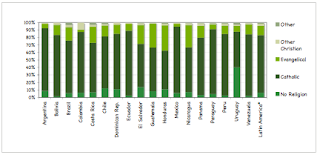I was bummed to have been outside the USA for the most riveting election in a generation, but it was pretty cool to be on the guest list for a party at the US Ambassador's residence. After the Ohio and Pennsylvania wins it was pretty obvious Obama had it in the bag, but I stayed up until the wee hours to watch history be made.
Here is a picture of the reception at the Ambassador's residence on election night.
At the event, the Ambassador had put on display a painting by one of Uruguay's most famous living painter, Carlos Paez Vilaró. It was inspired by the events of September 11 and will is a gift to the New York City Fire Department.
Another chance to for me to wear a tie came a few weeks later when the Uruguayan Ministry of Education and the US Ambassador had a joint press conference to announce the Uruguayan government's recent decision to commit funds to Fulbright scholarship exchanges with the US. I'm not sure if this will mean more scholarships for US students like the one I have, but it will definitely mean more Uruguayans in the US.
Probably the biggest piece of news coming out of Uruguay recently has been the Parliament's approval of a bill that would legalize abortion in the first 12 weeks of pregnancy. President Tabaré Vásquez vetoed the bill on "biological and philosophical grounds," as expected, and legislators did not have the necessary majority to override the veto. But the bill received major international attention as it would have given Uruguay Latin America's most liberal abortion laws outside of Cuba and Mexico City. It has come at an opportune time for my research on the role of religion in politics in this proudly secular country.
The debate over abortion reached a fevered pitch in Uruguay that was very familiar to American expats. Outside the legislative building during the vote, religious rock bands and hundreds of opponents of the bill gathered to protest. There was also a smaller and much quieter contingent of people supporting the bill, and one of them was carrying this sign, which humorously reads "Enough of your rosaries in our ovaries!"
This past November was an especially fun month to enjoy music around Montevideo. Our "cena de despedida" (goodbye dinner) for Fulbright was at the atmospheric Bar Tabaré, where an incredible tango singer only 23-years old named Francis Andreu performed. She had the raspy voice, the gravitas and the sass of a tanguera three times her age.
The other great concert I went to see was Bajofondo, probably the most well-known group of "electrotango" music. Its principal musician is Gustavo Santaolalla, who had become a big name for winning the Oscar for the theme song to Brokeback Mountain. Here they are taking a bow.
Another fun trip around Montevideo was to Barrio Reus, which is something akin to affordable housing from a century ago. The little homes fell into disrepair like much of the city, but one street in particular has been restored a brightly painted. I hadn't heard a thing about the neighborhood until a history professor tipped me off. It reminded me somewhat of La Boca in Buenos Aires, without the tourist hoards and nowhere to be found in any guidebook.
While it's been fun exploring the parts of the Rio de la Plata that are well off the beaten path, I still have fun living it up in the tourist playground that is Buenos Aires. The inflation there is ridiculous, but a strengthening dollar has somewhat balanced this out for American tourists. Here I am with Facundo (my Uruguayan boyfriend of 6 months, if you haven't caught on) in the Plaza de Mayo in early November. We had a lovely visit, and I scouted out some great restaurants for my family's visit before Christmas.
And last, my family will be happy to know that I celebrated Thanksgiving with good friends and lots of food. Besides a turkey (which cost a fortune here), we managed to scrounge up the ingredients for a very authentic Thanksgiving meal, and the food and wine kept us seated from 3pm to 9pm.































